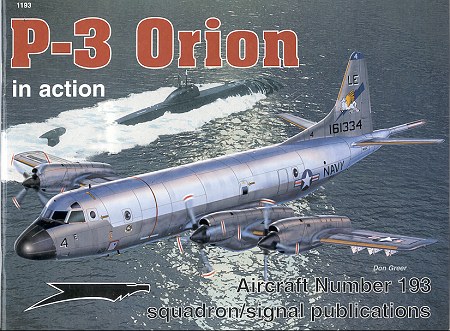 The release
of this edition of the 'In Action' series brings about a cheer and comments
of "its about time" from a number of us. During my long military career, I
was intimately involved with the P-3; first the EP-3B/E versions and later
the 'normal' P-3A/B/C variants both as an organizational level and later as
an intermediate maintenance avionics technician. USN types will know that
of which I speak.
The release
of this edition of the 'In Action' series brings about a cheer and comments
of "its about time" from a number of us. During my long military career, I
was intimately involved with the P-3; first the EP-3B/E versions and later
the 'normal' P-3A/B/C variants both as an organizational level and later as
an intermediate maintenance avionics technician. USN types will know that
of which I speak.
Without a doubt the most successful ASW/patrol aircraft
probably ever built, though there will be those who think that the Catalina
or the Viking might have a say about things. The P-3 has been one of those
aircraft that everyone interested in aircraft has seen, but has also
probably thought little about. The Orion holds (or at least held) the
world's speed record for multi-engine propeller driven aircraft and this
was done with a standard aircraft. It is also able to cruise with two of
its four engines shut down, making for properly long patrols (which is why
it has a galley and toilet). Its airframe is able to be utilized for
different roles other than that of ASW/Patrol and older airframes have been
so modified for use by Customs, Fire Bombing, and specialty roles by NOAA
and NASA to name a few. In addition to broad use in the US, the Orion was
license built in Japan by Kawasaki and has been sold to well over a dozen
different countries.
I can tell you from experience that the P-3 is not a
smooth-riding aircraft. Its short, stiff wings make for a bumpy ride unless
handled with care and precision by its flight crew or when on autopilot.
Rough weather has the crew firmly strapped in to prevent being tossed
around in the cabin. However, this stiffness makes it quite agile for its
size and it can quite easily be flown with aplomb should the need arise.
Thanks to its airliner beginnings, the Orion has an
incredibly long airframe time, with even older P-3A airframes left with
thousands of hours of operation in them. In fact, US P-3s have been retired
not due to airframe fatigue, but more to having more modern versions
available. Even older airframes have had their electronic suites updated
several times to meet the changing needs of the mission.
Overall, I'd have to rate this as an outstanding reference
on the type, though I may be a bit biased in that regard!
You can find this book and many others at

For those of you who can't get enough P-3 pics, here are a
few I've taken from various postings over the years.
 YP-3A as operated by NASA, Keflavik 1988
YP-3A as operated by NASA, Keflavik 1988
 EP-3B with VQ-1, Atsugi 1975
EP-3B with VQ-1, Atsugi 1975
 NP-3D from VXN-8 (El Coyote), Keflavik, 1988
NP-3D from VXN-8 (El Coyote), Keflavik, 1988
 P-3C with VP-26, Diego Garcia 1980
P-3C with VP-26, Diego Garcia 1980
 P-3C with VP-46, Diego Garcia 1986. This is during the time when tail
markings were being removed from the fleet as you can see from the aircraft
to the rear.
P-3C with VP-46, Diego Garcia 1986. This is during the time when tail
markings were being removed from the fleet as you can see from the aircraft
to the rear.
 TP-3 from VP-30, London, 1997
TP-3 from VP-30, London, 1997
 CP-140, Keflavik, 1987
CP-140, Keflavik, 1987
 P-3C? from 333 Sq, Keflavik, 1988
P-3C? from 333 Sq, Keflavik, 1988
If you would like your product reviewed fairly and quickly by a
site that has well over 250,000 visitors a month, please contact
me or see other details in the Note to
Contributors.
 The release
of this edition of the 'In Action' series brings about a cheer and comments
of "its about time" from a number of us. During my long military career, I
was intimately involved with the P-3; first the EP-3B/E versions and later
the 'normal' P-3A/B/C variants both as an organizational level and later as
an intermediate maintenance avionics technician. USN types will know that
of which I speak.
The release
of this edition of the 'In Action' series brings about a cheer and comments
of "its about time" from a number of us. During my long military career, I
was intimately involved with the P-3; first the EP-3B/E versions and later
the 'normal' P-3A/B/C variants both as an organizational level and later as
an intermediate maintenance avionics technician. USN types will know that
of which I speak. 







